C2 Use of English [Proficiency] – TOP Tips to ace this section of the exam
In recent times, I’ve completed many C2 Proficiency practice examination Use of English tasks in an effort to challenge and develop myself as a teacher of English. The Use of English section appears together with the Reading section of the exam in what is known as the C2 Proficiency Reading and Use of English Paper. I've recently prepared a complete guide to the C2 Proficiency Reading section so do check it out.
This post details the four task types in the Use of English section of the paper. I also provide an abundance of tips as to how you can achieve the highest mark possible for each task.
What task types make up the Use of English section of the C2 Proficiency Reading and Use of English paper?
The Reading and Use of English paper contains seven parts. There are 53 questions in total, with a maximum of 72 marks up for grabs. The Reading section of the paper consists of parts 5, 6 and 7 with 36 marks available. The Use of English section encompasses parts 1, 2, 3 and 4 (36 marks):
1. Multiple-choice close task
2. an open cloze task
3. a word formation task
4. a key word transformations task
Essentially, the Use of English section tests your ability to demonstrate your control of English by doing different tasks at both text and sentence level. You will have the chance to show your knowledge of a range of grammatical forms and lexical items, and your ability to apply them correctly and appropriately.
Candidates are able to take Cambridge exams either digitally (typing answers directly onto a computer) or in paper format.
Text types
There are four texts in the Use of English section. These texts are chiefly contemporary and taken from academic, journalistic and literary sources. Texts tend to be in the form of extracts from reports and articles, meaning that the content is mostly factual or informational. Occasionally, these texts contain opinions.
As you can imagine, texts are exceedingly dense and complex, with long sentences containing several clauses with very high-level use of grammatical structures.
The titles provide candidates with an early idea of what to expect from the text, and to help them apply their predictive reading skills.
C2 Use of English - Part by Part
Now that you aware of the types of tasks you will encounter in the Use of English section of the C2 Proficiency exam, let’s focus our attention on each individual task type. I will describe each task type in more detail and give some tips as to how you can achieve the highest mark possible for each task.
Part 1 - Multiple-Choice Cloze Task [8 questions / 8 marks]
The first part of the C2 Proficiency Reading and Use of English paper revolves around completing a Multiple-Choice Cloze task. In essence, candidates are presented with a single text with eight gaps. They have to choose one word or phrase from a choice of four to fill each gap. There are eight questions with one mark available for each correct answer.
This part of the C2 proficiency reading section comprises a text drawn from a range of different sources. Text types include newspaper articles, encyclopaedia entries, literary texts and advertisements.
What does the Multiple-choice Cloze Task test?
According to the Cambridge English C2 Proficiency Handbook for Teachers from 2023, the gapped answers and the words immediately surrounding the gaps are firmly connected with lexis or lexico-grammar. Lexico-grammar refers to the interdependence of syntax (grammar - the arrangement of words in a sentence) and lexis (i.e. vocabulary) to create meaning. Lexico-grammar is also the focus of the Open Cloze Task (Use of English) in part 2 of the paper.
Mark Harrison, author of a wide range of practice test books for Oxford University Press and Macmillan, adopts a slightly different stance to Cambridge in his book Proficiency Testbuilder (2013). Indeed, Harrison (2013, p.9) states that part 1 of the Reading and Use of English paper focuses on vocabulary with particular emphasis on the following areas:
- Complementation - The term complementation is used in the analysis of grammatical function, referring to a major constituent of sentence or clause structure. It is traditionally associated with ‘completing’ the action specified by the verb. For example, a complement may assume the role of an object (“He kicked the ball”) or an adverbial (“He is in the forest”). In simple terms, then, candidates should choose the right option that fits grammatically. It may be the case that more than one of the options has the correct meaning. However, only one choice will form a grammatically correct structure.
- Semantic precision - Semantic precision refers to the accuracy and specificity with which meaning is conveyed in communication. Put simply, you must decide which option has the correct meaning in relation to the meaning of the sentence or indeed the text as a whole.
- Linkers - Words or phrases which connect sentences or parts of sentences. Questions testing linkers involve choosing from single-word linkers, deciding which word completes a linking phrase or choosing from complete linking phrases. All in all, linkers fall under the category of lexico-grammar.
- Phrasal verbs - Another test of candidates’ lexico-grammatical knowledge, questions may involve selecting which single word completes a phrasal verb or choosing from a set of complete phrasal verbs.
- Collocation - Selecting which word goes together another or others to form a phrase. The very nature of collocations means that it may be possible to fill the gap with another word which isn’t an option in the question. However, only one of the words provided as an option correctly completes the phrase.
- Idioms - Phrases that have a special meaning, which may be significantly different from the meaning of the individual words in them. Questions testing idioms revolve around choosing which single word completes the idiom.
- Fixed phrases - Phrases in which the individual parts always appear together. Unlike idioms, the meaning can be logically deciphered based on the meaning of the individual words in them. Therefore, questions testing fixed phrases involve knowing which single word completes them.
In summary, some questions in part 1 of the C2 Proficiency Reading section focus on the meaning of individual words in context. Other questions may revolve around fixed items of language such as collocations, fixed phrases and idioms. Lexico-grammar is also tested through phrasal verbs and linkers. The choice of the correct option may also assume a grammatical element. Indeed, the answer may be correct because, for instance, it is the only one of four verbs which fits the structural pattern or it naturally precedes the subsequent preposition.
How long should candidates spend on part 1 of the C2 Reading and Use of English paper?
I recommend candidates to spend no longer than FIVE minutes on part 1 of the C2 Reading and Use of English Paper.
An Example of a Multiple-choice Cloze Task

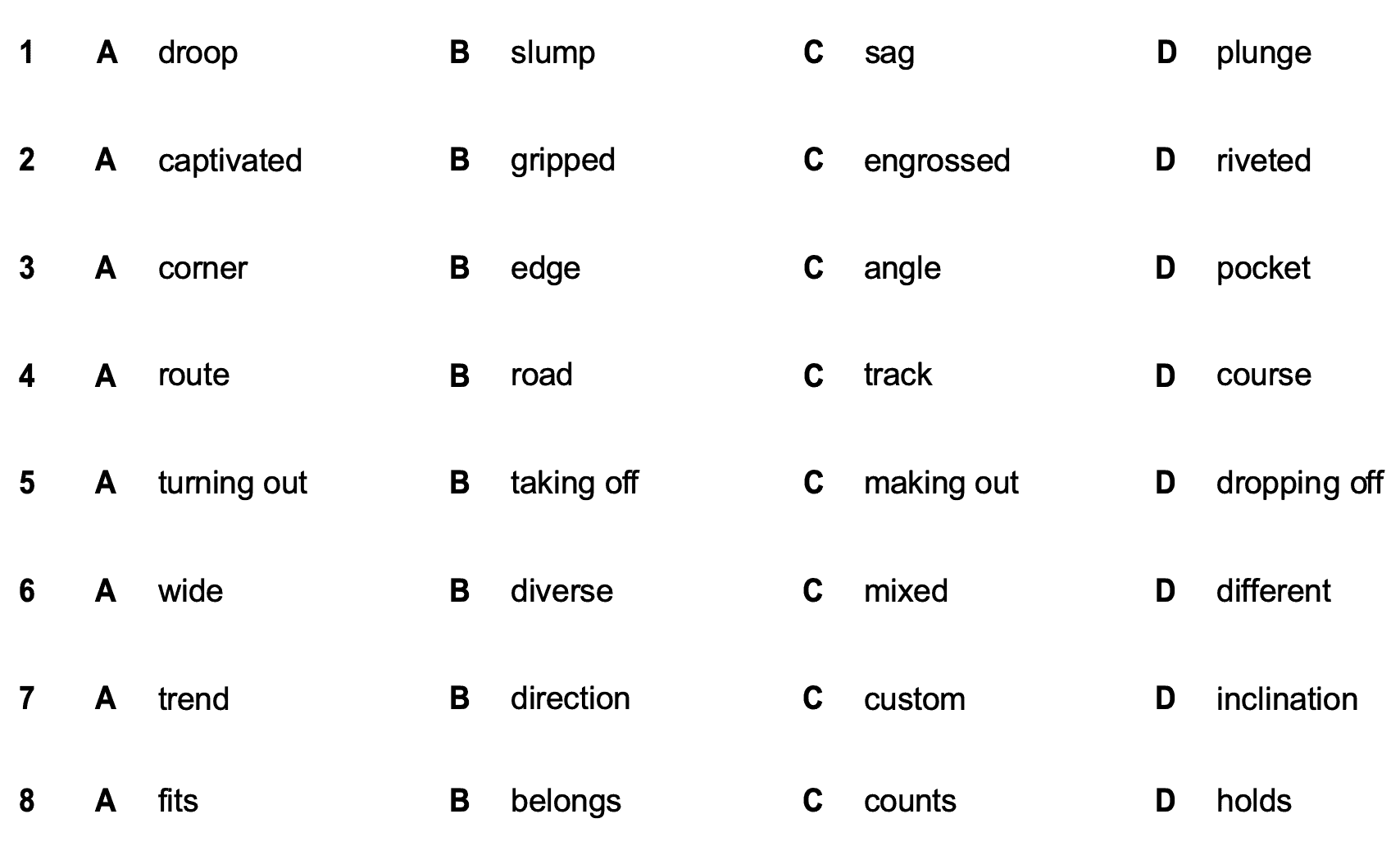
Cambridge English Reading and Use of English Sample Test 1
* Solutions to all sample tasks can be found at the end of this post.
Tips for acing part 1 of the C2 Reading and Use of English Paper
Completing a dozen or so authentic examination Multiple-choice Cloze tasks in recent weeks has helped me to come up with the following tips to help you ace part 1 of the paper:
1. Consider the whole text
You should read the text very carefully to ensure that the options you choose make sense in terms of the meaning of the text. Focusing on a few words immediately before or after a gap might lead you to incorrectly choose an option as it does not agree with the context of the text. This is despite the fact that the option might seem to fit grammatically and in isolation.
Don’t let carelessness creep in. In the example below, I foolishly selected option B (moreover) in question 2 because it made perfect grammatical sense:
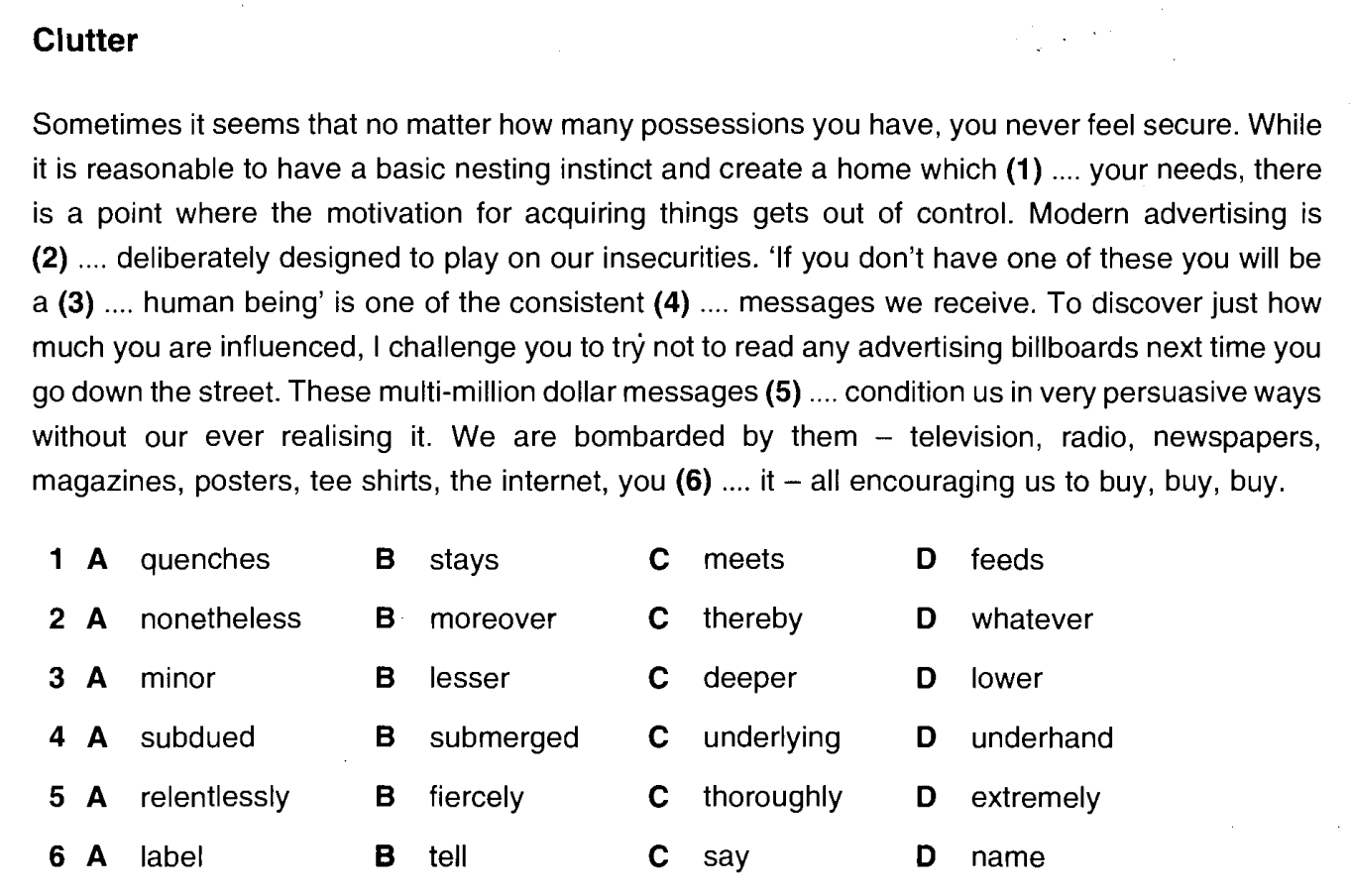
Source: Cambridge Certificate of Proficiency in English 1, 2001, p.83
Unfortunately, I didn’t pay attention to the fact that no reference at all is made to ‘Modern advertising’ in the first two sentences, thus ruling out moreover. Furthermore, the word moreover must have a comma before and after it if used in the middle of a sentence. Being quite well read, and having taught essay writing at university level in the past, I think I am quite up on the use of commas with transition words, such as moreover. However, the fact I failed to notice an absence of commas before and after the word moreover proves just how careless I was here.
2. Don’t let your answers defy logic
On the rare occasion that I select the wrong option for a question in part 1 of the C2 proficiency reading section, it is usually because I choose the answer which has the most obvious connection with the situation being described. In the example below, I couldn’t forgive myself for choosing option C for question 9:

Source: Cambridge Certificate of Proficiency in English 2, 2000, pp.58-59
I went with the word splattered because I associate this word with water and “waves” more than the other options. However, splatter refers to large drops of liquid falling or hitting something noisily. This definition certainly does not describe huge waves SMASHING over the promenade! Hence, the answer is A - smashed.
Context counts
Let’s briefly focus on gap 12 In the text below about Lake Vostok in Antarctica:

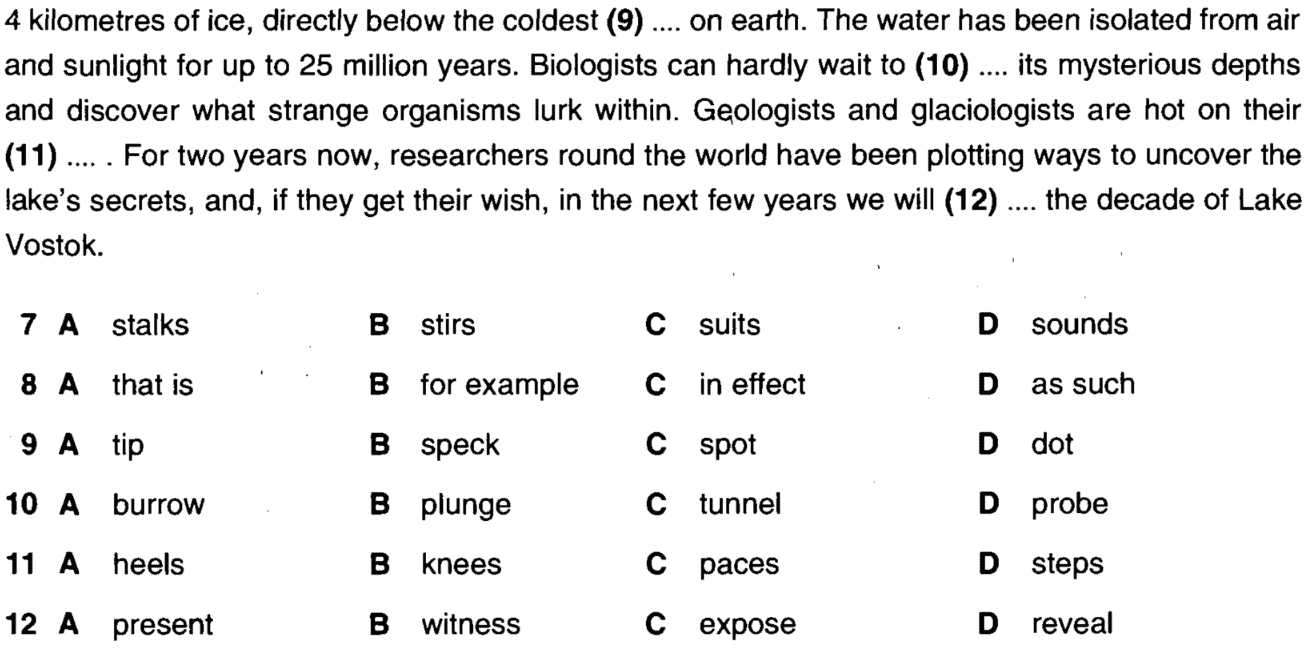
Source: Cambridge Certificate of Proficiency in English 1, 2001, pp.56-57
To my mind, the key word in the entire sentence is ‘we’. Don’t be fooled by the word ‘researchers’. It is only really the researchers who can either ‘present’ (A), ‘expose’ (C) or ‘reveal’ (D) “the decade of Lake Vostok”. However, we, as observers, readers and non-specialists, can ONLY ‘witness’ (B) “the decade of Lake Vostok”.
Overall, this is the single best piece of advice I can give you:
Re-read the sentence containing the gapped word twice to make sure that your choice does not defy logic.
Part 2 - Open Cloze Task [8 questions / 8 marks]
Part 2 of the C2 Reading and Use of English paper is an open cloze task. In a nutshell, the task consists of a short text with EIGHT gaps. There’s also an example at the beginning (0). One mark is awarded for each correct answer.
You have to fill each gap by identifying the missing words. Note that a SINGLE WORD is needed to fill each gap - never a contraction or phrase. There may be more than one acceptable word for a gap. These words appear in the mark scheme compiled by Cambridge English.
Unlike part 1, this is not a multiple-choice task. You must utilise your knowledge of the structure of English and ability to grasp the context of the text in order to fill the gaps.
For part 2, it’s vital that you write/type your answers IN CAPITAL LETTERS. Each word must be correctly spelt.
What does the open cloze task test?
The open cloze task of the Use of English section generally tests a candidate’s awareness and control of grammar. However, the focus of the gapped words may also be lexico-grammatical, that is areas which may be considered part-grammar and part-vocabulary. Examples of lexico-grammatical areas include linking words and phrases, parts of phrasal verbs, and verb, adjective and noun complementation (e.g. prepositions used after these).
As the gapped words tend to be grammatical in nature, they are usually short and high-frequency ones, such as prepositions (in, on) and articles (a, the). However, these ‘simple’ words will be placed within a relatively complex setting.
What common parts of speech are often tested in part 2 of the C2 Reading and Use of English paper?
Parts of speech that are often gapped include:
- Prepositions - without, result in, regardless of
- Multi-word prepositions/prepositional phrases - except for, apart from, out of order
- Subordinating conjunctions - although, while, unless, until, in order to
- Multi-word conjunctions - in order that, as long as, so as to, provided that
- Relative pronouns - who, which
- Linkers - moreover, let alone, far from, regardless of
- Phrasal verbs - set someone apart, turn up
- Fixed phrases - by no means, when it comes to, to such an extent, as a rule
- Graded quantifiers - many, fewer
- Idioms/collocations - (it) goes without saying, (in) one way or another, on the horizon, kill time, take place
How long should candidates spend on part 2 of the C2 Reading and Use of English paper?
I recommend candidates to spend no longer than FIVE minutes on part 2 of the C2 Reading and Use of English Paper.
The most proficiency candidates should be able complete this task in three minutes.
An Example of an Open Cloze Task

Solutions to sample tasks can be found at the end of this post.
Tips for acing part 2 of the C2 Reading and Use of English Paper
1. First of all, look at the title and briefly skim the entire text in order to grasp what the text is about.
2. Read the whole text again ignoring the gaps.
3. Read the text again sentence by sentence, as opposed to line by line. Pay attention to the words and structures before and after each gap as they may form part of a phrase or expression which is completed by the missing word.
4. If it helps, read the sentences both before and after the whole sentence with the gap in it. Many answers may require you to recognise the flow and connections between ideas and information in the text. Indeed, awareness of the writer’s train of thought and logical argument plays a substantial role in the C2 Proficiency Reading and Use of English paper. If you consider each gap in isolation, you may produce an answer which appears to make sense within the narrow context of the few words either side of the gap. However, you will find that the answer does not make sense within the context of the text.
5. If you struggle, it may help you to read through the whole article carefully and decide which type of word is missing from each gap, e.g. a question word, a preposition, a verb or a noun etc. You might also reach the conclusion that the missing word makes up a phrase or idiom.
In the sample text above, it’s obvious that gap 9 is a question word (why?) because of the question mark.
6. Look for a referent (e.g. names; places; pronouns, he/they, etc.) in another part of the sentence. Make sure that the word you write in the gap agrees with the subject.
7. In gap 12 in the text below, I must admit that I jumped the gun when I selected the word spite. The answer is view. Of course, in spite of the fact that is a very common chunk of words in English - much more common I'd say than in view of the fact that. Always have in mind that there are no easy marks in the C2 Proficiency exam. Alarm bells should ring if you recognise a gapped word in a split second based on surrounding words which combine to create a common chunk, just like in spite of the fact that. Take a deep breath and reread the sentence again because the gapped word probably isn't the one you think it is.

Source: Cambridge Certificate of Proficiency in English 4, 2006, p.72
8. When you have finished, read the whole text again to make sure that it reads well and makes sense.
In the lead up to taking the C2 proficiency exam, how can you boost your chances of getting a top mark for part 2 of the Reading and Use of English Paper?
Perhaps more than anything else, this task revolves around the knowledge and recognition of grammatical patterns, fixed phrases, prepositional phrases and multi-word conjunctions.
I tend to advise candidates to seek out as many academic and journalistic articles as possible, and then initiate the process of noting down the many grammatical patterns and multi-word phrases they come across. If it helps, these articles can relate to an area of personal interest. It would also be a prudent move to seek out as many sample/past C2 (previously CPE) Reading and Use of English papers as possible for the purposes of picking out phrases.
The following paragraph is from an article titled ‘The Role of Positive Emotions in Positive Psychology: The Broaden-and-Build Theory of Positive Emotions’ by Barbara Fredrickson (2001):
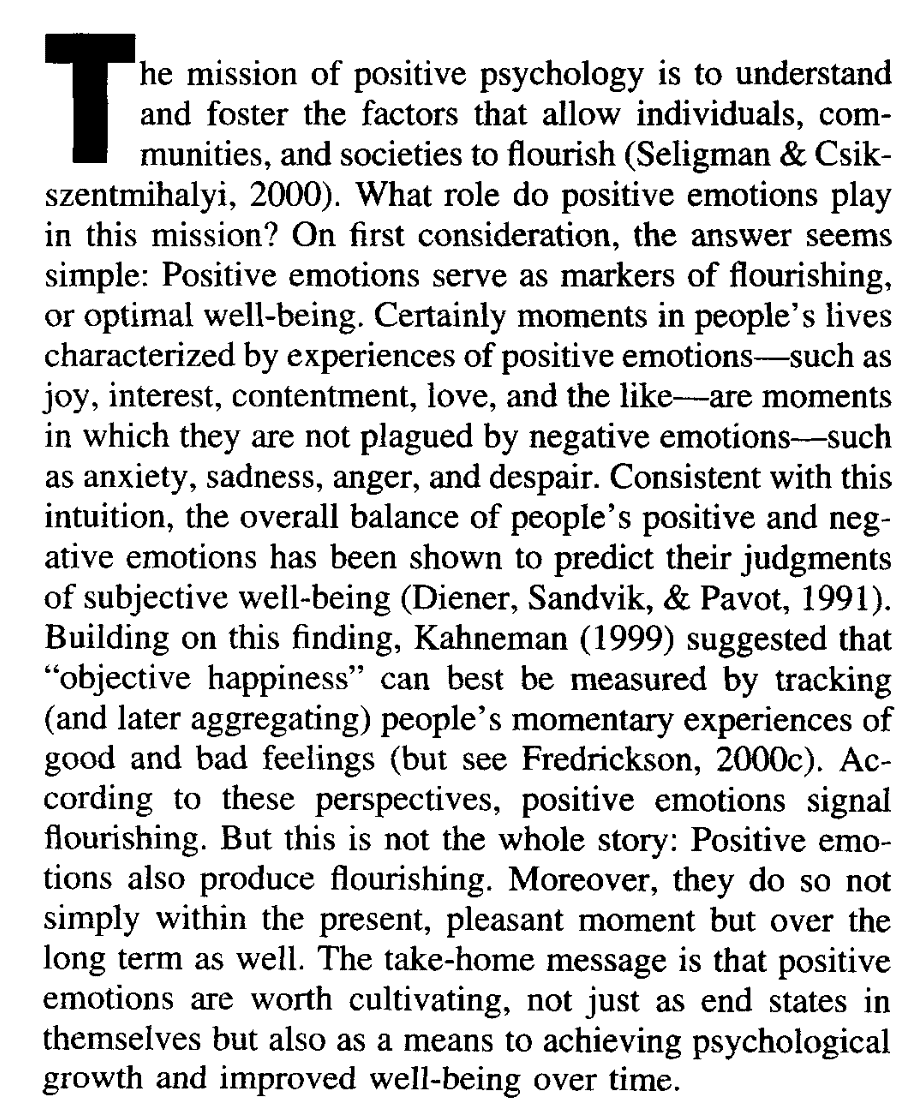
Evidently, this paragraph is just what the doctor ordered when it comes to preparing for part 2 of the Reading and Use of English Paper. Remembering that the missing words tend to be grammatical in nature, and are thus rather short and simple, it would be worth making a note of the following grammatical patterns and phrases:
- On first consideration
- serve as
- characterised by
- in which
- Consistent with this
- According to
- the whole story
- within the present (moment)
- over the long term
- not just as
- in themselves
- as a means to
All of the words in bold are the kind which you may have to fill the gaps with. The next step would be to add these phrases/chunks of words to a table. For example, you can do this on a Google Doc. After that, I would recommend you to try to find synonyms for relevant multi-word items. For example, I have a feeling that according to may be a bit too simple to appear in a C2 Use of English task. However, this does not mean you cannot search for equivalent terms in a good online dictionary. I have found the following synonyms for according to:
- in accordance with
- in conformity with
- in line with
- as claimed by
You can also add these synonyms to the entry for according to in your table. For some entries, you may wish to add whole sentences containing the target phrases so that you have greater context and as a potential memory aid for the target phrases. You can find example sentences in any reputable online dictionary, such as Cambridge Dictionary.
Part 3 - Word-Building Task [8 questions / 8 marks]
Part 3 of the C2 Use of English paper is a Word-Building task. Candidates should read the text and complete the EIGHT numbered gaps with a form of the word in capitals at the end of the line. This word at the end of the line is known as, among other terms, a stem word. There is an example at the beginning of the text. This example is taken from the sample Word-Building task which follows below:
As you can see, the stem word is EFFECT (a noun). You would have to change effect into EFFECTIVE (an adjective) to complete the gap.
ONE mark is awarded for each correct answer. Each word must be correctly spelt.
What does the Word-Building Task test?
The focus of the Word-Building Task is mainly lexical (e.g. compounding, affixation, suffixation).
As the very nature of the term Word-Building suggests, most questions involve producing a word that is longer than the word given, especially when adding affixes. However, you may have to produce a shorter word for some questions, for example changing the adjective greedy to the noun greed.
How long should candidates spend on part 3 of the C2 Reading and Use of English paper?
I recommend candidates to spend no longer than FIVE minutes on part 3 of the C2 Reading and Use of English Paper.
An Example of a Word Formation Task
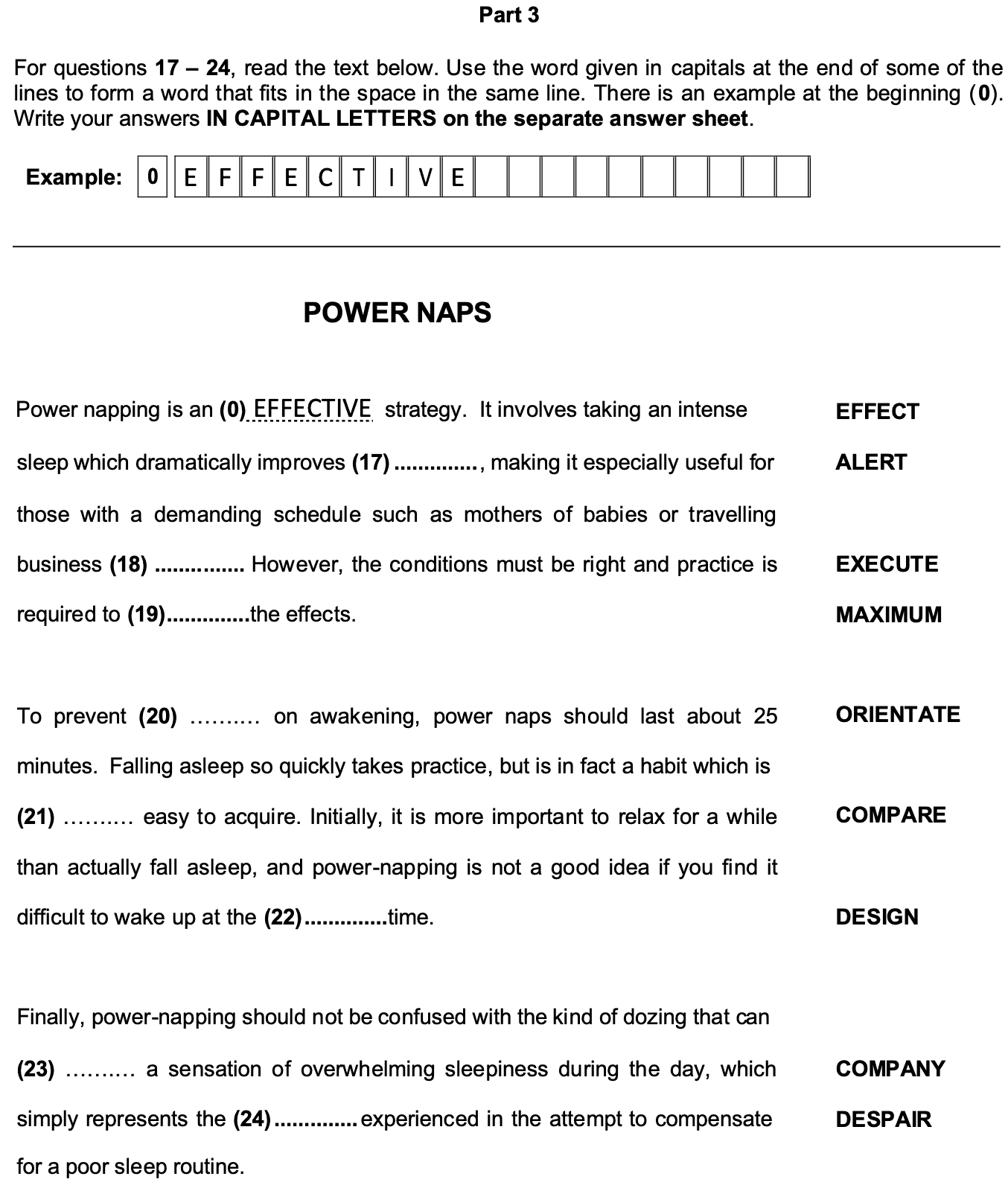
How can you maximise your chances of getting a top mark in part 3 of the C2 Reading and Use of English Paper?
1. As with part 2, begin by skim-reading the text, ignoring the words provided.
2. The first step in the word-building process is deciding which part of speech the missing word in each gap should be. More of than not, you will have to form a noun from a given verb or an adjective from a given noun. Less commonly, you may have to form an adverb from a noun. Some questions may also involve creating a different word that is the same part of speech, for instance changing an adjective into a negative adjective.
You should possess enough basic grammatical knowledge to work out from the context what part of speech the word you have to form must be.
For example, it should be common knowledge that bare infinitives follow modal verbs such as may, could and, in the example below, can. Therefore, the only viable infinitive form related to the base word company is accompany:

4. Having identified what part of speech the gapped word should be, you would then need to consider the type of word formation that is required. The types of word-building involve the following:
(a) Affixation:
Affixation refers to the process of adding affixes (namely prefixes and suffixes) to a word to a base word to form a new word. Common prefixes include un-, im-, dis- and over-. As for suffixes, common examples include -al, -ful, -ment and -tion.
At this level, Cambridge English tends to demand that you supply both a prefix and a suffix to form the required word. Therefore, it may be useful to learn that im- is used before the letters m and p, as in immobile and impatient. However, Cambridge English may be more inclined for candidates to supply a prefix and suffix for a negative noun based on a stem word that is a verb.
In the example below, the verb orientate should be changed into a noun which requires knowledge of both the required prefix (-dis) and required suffix (-ion). The gapped word is disorientation.

This example with disorientation proves the point that, even if you don’t know what the gapped word is on the basis of the stem word, you can still draw on your knowledge of English to produce a word which you feel sounds correct. The verb prevent suggests that the following noun is negative in its relation to awakening. Next, you can consider the first letter of orientate - 'o'. In order to create the negative form of nouns beginning with the letter ‘o’, such as organisation, obedience and order, you often need to add the prefix dis-. That’s one clue. The second clue for this particular gapped word revolves around the suffix -ate. You can refer to your knowledge of English again to work out that verbs ending in the suffix -ate, such as imitate, tend to take the suffix - tion in the noun form (imitation).
Common affixes and changes to word forms
- verb to noun - act to interaction
- verb to plural noun - apply to applicants
- noun to adjective - flaw to flawless
- noun to negative adverb - effect to ineffectively
- adjective to negative adverb - definite to indefinitely
- adjective to verb - deep to deepened
(b) Internal/ Grammatical changes
You may have to change some words in ways which do not involve the addition of affixes. For example, changing the noun thief to the verb thieve.
Word-building also involves making internal changes to the stem word, for example, strong to strengthened. Therefore, any number of changes may be made to the stem word, including subtle changes in spelling. A subtle change in spelling appears in the transformation of vary to invariably with the ‘y’ in vary becoming ‘i’ in the middle of invariably. As another example, changing doubt to undoubtedly amounts to three changes, not forgetting that other letters have also been added (-ed) to form a negative adverb.
(c) Compounding
Occasionally, you may have to change the stem word to form a compound word. In the example below, you would have to add -fall to rain to create the compound noun rainfall.

Have a go at completing this C2 word formation exercise.
Final Thoughts and preparing for the Word-Building Task before the exam
Having completed a large number of sample Reading and Use of English papers in recent weeks, I find it easier to do word-building tasks than Open Cloze (part 2) and Key Word Transformation tasks (part 4). Frankly, I am disappointed if I don’t get 100% on every Key Word Transformation task I do.
Of course, it’s mightily difficult to prepare for a C2 Word-Building task. After all, it’s impossible to get to know the range of words that can be formed from the many tens of thousands of base words there are, including all the negative forms. However, I’d like to leave you with one final piece of advice. The stem words provided by Cambridge English tend to be fairly common nouns and verbs. Occasionally, Cambridge may provide an adjective as the stem word.
I’ve just found stem words such as break, close, progress, repeat and regular in sample papers. This suggests to me that, while reading a text, you can try to judge which verbs, nouns and adjectives are ‘common’.
I’ve just found an article on the BBC website about how holiday resorts are rethinking the all-inclusive holiday. If I were preparing for part 3 of the C2 Use of English exam, I would do the following with this article:
1. If you deem a noun or verb to be ‘common’, stop reading at the end of the sentence or paragraph the word appears in
2. Head to Chat GPT and type ‘What are all the affixes of the word ____’ or ‘What are all the prefixes and suffixes of the word ___’. One search query may throw up a more complete set of results than the other search query so it’s worth comparing ‘affixes’ with ‘prefixes and suffixes’:

3. For example, the word adventure appears in the article. Here are the results from ChatGPT:
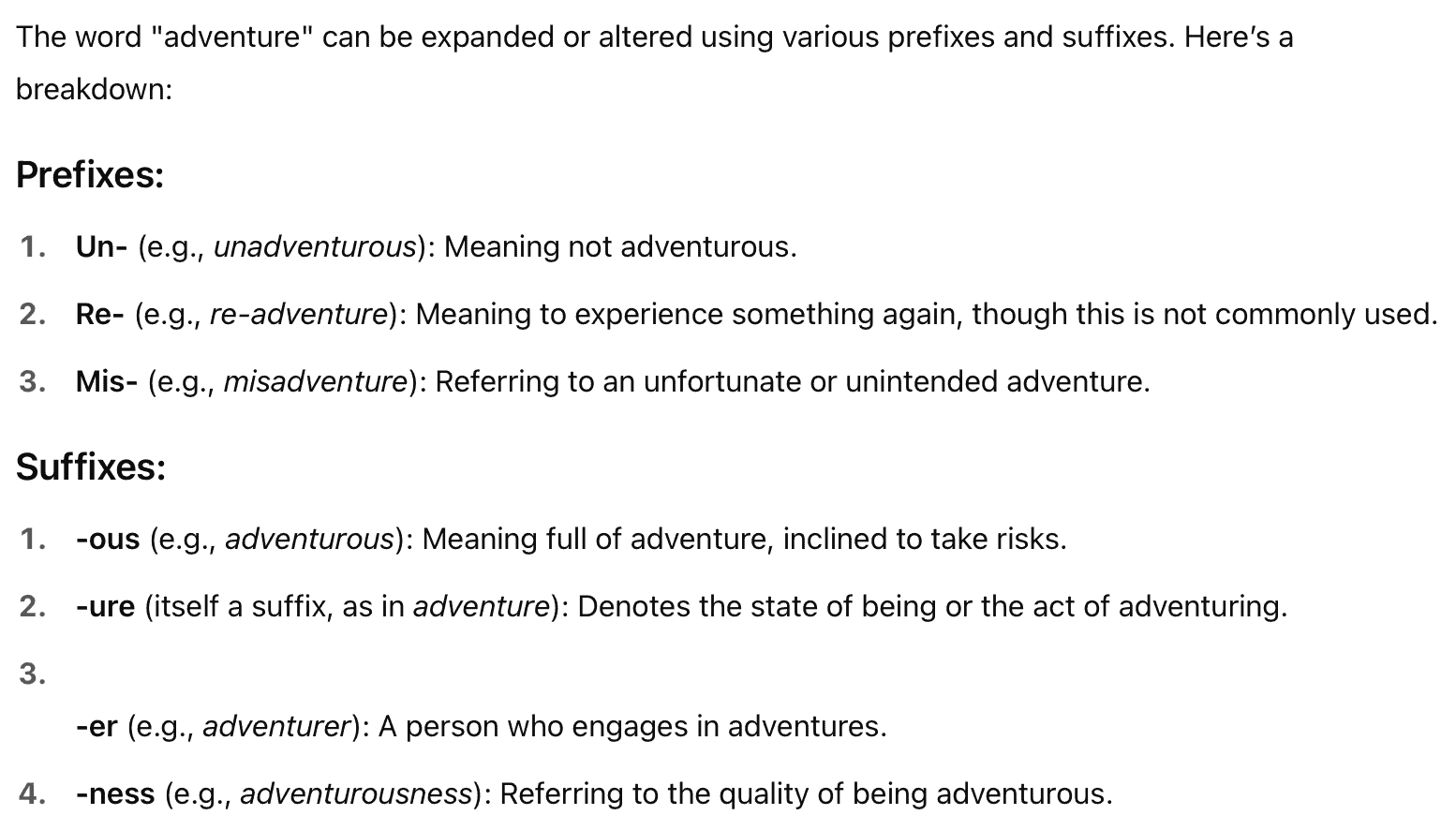
You can then create a Google Doc with the stem words in the left-hand column and the affixes in the right-hand column. Moreover, you can add definitions and example sentences containing variants of the stem word should you wish to.
Part 4 - Key Word Transformations Task [6 questions / 12 marks]
Part 4 of the C2 Use of English paper is a Key Word Transformations task.
You have to complete six key word transformations. Each question contains three parts: a lead-in sentence, a key word and second response sentence of which only the beginning and end are given. Therefore, you have to fill the gap in the second sentence so that it is similar in meaning to the lead-in sentence. It is vital that you use the key word in bold. You can use between three and eight words including the given word in the transformation sentence.
Here’s an example transformation question:

Possible solutions as given by Cambridge English:
resignation / resigning / decision to resign came (1 mark) + as a (total/complete) surprise / shock to (1 mark)
It’s crucial that you use the key word in your answer, and you must not alter it in any way. If you do not use it or if you change it, you will not be awarded the marks. When you write/type your answers, you only need to write/type the words that are needed to fill the gap and not the whole sentence.
How long should candidates spend on part 4 of the C2 Reading and Use of English paper?
I recommend candidates to spend no longer than TWELVE minutes on part 4 of the C2 Reading and Use of English Paper. This equates to two minutes per question.
An Example Key Word Transformations part from a Sample C2 Reading and Use of English Paper
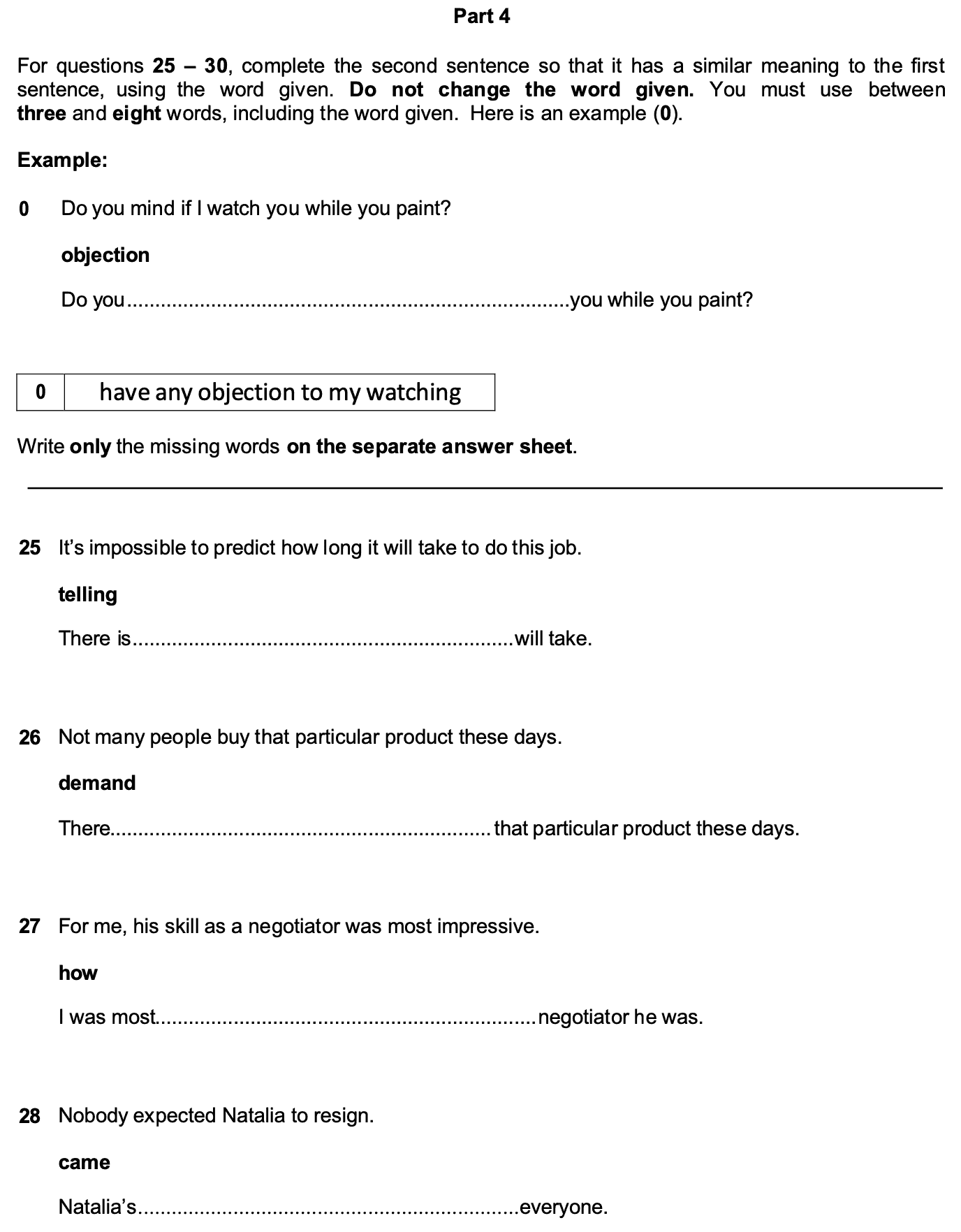
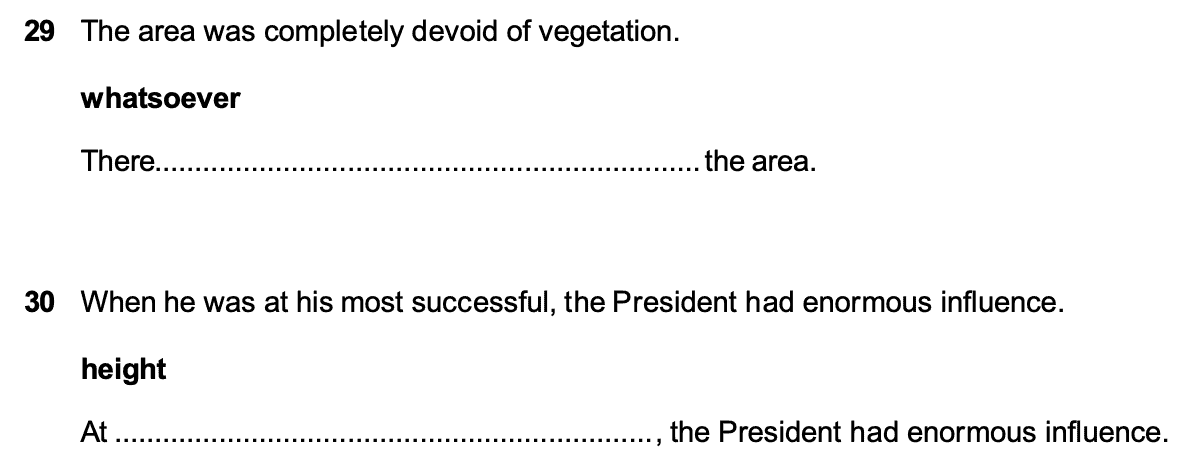
What does the Key Word Transformations task test and what’s the best way to approach the task?
The focus of the Key Word Transformations Task is on grammar, vocabulary and collocation. Candidates are required to manipulate sentence structures and lexical phrases in their answers.
To reiterate, each answer must consist of between three to eight words. If you write more than eight words, you will not be awarded the marks. You must remember that contractions count as two words (won’t = will not).
The answer you write is separated into two distinct parts. Each part is worth ONE mark. Therefore, you may score 0,1 or 2 marks depending on the accuracy of the response. In effect, then, there are really two ‘pieces of language’ to produce for each answer. In any question, either of the ‘pieces’ may involve:
- the transformation of one grammatical structure into another;
- the production of a lexical phrase, such as a phrasal verb, a fixed phrase, an idiom, a collocation, a linking phrase or a phrase with the correct complementation (complements complete the meaning of a sentence and include subject complements and object complements);
- changing a word from one part of speech to another, such as forming a noun from a given adjective.
Make sure to write a complete answer to each question. Even if you are unsure whether your whole answer is correct, it is possible that one of the two parts will be. Indeed, as the example at the beginning of this analysis of part 4 about “Lucy’s resignation” shows, you can get a mark for simply transforming a verb/to-infinitive into a noun.
It’s also vital that you read the words on both sides of the gap carefully. These words provide you with crucial information about the nature of the correct answer.
Key Word Transformation - Noticing Patterns
It’s very difficult to give advice about how to prepare for the Key Word Transformation task. The only thing I urge candidates to do is to seek out sample papers, past examination papers and Key Word Transformation exercises online and practise. Even if you struggle at first, it will get easier as you begin to recognise grammatical patterns in the answers. You can record new structures and chunks in a notebook or on a Google Doc.
Here are two grammatical items, followed by lexical chunks, which may crop up in this C2 Use of English part:
1. Saxon Genitive followed by a noun

Let’s return to the example I provided earlier. As Lucy is followed by an apostrophe (‘) + s to indicate possession (known as the Saxon Genitive), the following word would most likely be a noun. The verb resign immediately stands out for its potential to be ‘transformed’. Therefore, the noun of resign is resignation. By recognising this, and adding the word came after resignation, you have already secured one mark: Lucy’s resignation came |
Judging by the answer keys, Cambridge English is quite flexible with the answers in part 4. After all, both ‘resigning’ and ‘decision to resign’ are acceptable alternatives to ‘resignation’. However, I think it’s easier to just go with a noun after the Saxon Genitive.
Your knowledge of collocations would have to come into play in the next part: Lucy ’s resignation came (1) | as a surprise / shock to everyone (1)
2. Passive structures

This question should be straightforward for students at this level. The fact that the word Passengers now appears at the start of the answer suggests that a passive structure is required. Always double check the tense in the first sentence. Here we have the present simple tense, which equates to the following in the passive:
Passengers are asked / requested to | [1]
The word ‘to’ indicates that a to-infinitive should follow:
Passengers are asked / requested to | remain
Finally, you can complete the transformation in one of two ways:
Passengers are asked / requested to | remain seated / in their seats [1]
3. Inversions

Although they're somewhat old-fashioned, Cambridge English does like to test candidates on inversion, for example:
- Inversion after negative adverbials, such as never, not only and hardly.
- Inverted conditionals
In the example above, we have a case of inversion in the third conditional with the following solution:
Had it not been for Nick's advice [1] I would / I'd [1]
Final piece of advice for preparing for part 4 of the C2 Reading and Use of English Paper
Apart from practising from sample papers, past papers and exercises online, you can also practise your paraphrasing skills using different grammatical structures and synonyms/other lexical chunks by rewriting sentences from texts you have read. This can only help you develop flexibility in language use.
I’m available to check your paraphrases.
Final Thoughts
Honestly, it’s not the case that I achieve 100% for every single C2 Use of English task I attempt. Although I tend to achieve 100% for the Word-Building tasks, I tend to operate at around 90-95% for parts 1,2 and 4 combined. I believe that most well-educated native speakers of English, without any background in English Language/Linguistics, would do well to get over 70% in total for the four parts of the Use of English section.
When it comes to English language learners who get over 90% in total for the Use of English parts, I take my hat off to them.
Extras
Contact me for help with preparing for the C2 Reading and Use of English paper
Solutions to the C2 Use of English sample tasks in this post
Part 1 - Multiple-Choice Cloze Task:
1. B - slump
2. C - engrossed
3. A - corner
4. C - track
5. B - taking off
6. B - diverse
7. A - trend
8. C - counts
Part 2 - Open Cloze Task:
9. why
10. after
11. between
12. time
13. on
14. more
15. as
16. place
Part 3 - Word-Building Task:
17. alertness
18. executives
19. maximise / maximize
20. disorientation
21. comparatively
22. designated
23. accompany
24. desperation
Part 4 - Key Word Transformations Task:
25. no (way / chance of) telling | how long this/the job/work
26. is | (very) little demand for OR is not/isn't | a lot of/much (of a) demand for
27. impressed to see/by/with/at | (just) how skilled/skilful/skillful a
28. resignation / resigning / decision to resign came | as a (total/complete) surprise / shock to
29. was no / was not any vegetation | whatsoever in OR was nothing | whatsoever growing in
30. the height of | his success
Online resources and exercises for the C2 Use of English tasks
Cambridge English Proficiency Handbook for Teachers
References:
Cambridge Examinations Publishing, (2001).Cambridge Certificate of Proficiency in English 1, Cambridge: Cambridge University Press
Cambridge Examinations Publishing, (2002) Cambridge Certificate of Proficiency in English 2, Cambridge: Cambridge University Press
Cambridge Examinations Publishing, (2006) Cambridge Certificate of Proficiency in English 4, Cambridge: Cambridge University Press
Fredrickson, B.L., (March 2001). ‘The Role of Positive Emotions in Positive Psychology: The Broaden-and-Build Theory of Positive Emotions’, American Psychologist, Vol.56, No. 3, 218-226
Harrison, M., (2014) Proficiency Testbuilder, 4th edn. Macmillan Education

![C2 Use of English [Proficiency] – TOP Tips to ace this section of the exam C2 Use of English [Proficiency] – TOP Tips to ace this section of the exam](https://englishcoachonline.com/wp-content/uploads/bfi_thumb/dummy-transparent-ral0h0gsu990ghadwzzt5cos8uzg4mp48vf6dyet76.png)

